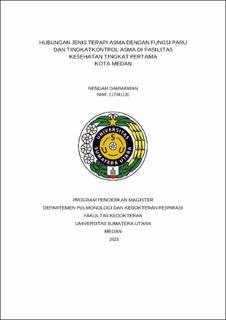| dc.description.abstract | Asthma is a commonly encountered disease that generally affects 1–18% of the world's population. A gradual approach to asthma control is the main foundation for managing symptoms, preventing acute asthma exacerbations, and improving lung function. Many asthma patients remain uncontrolled despite numerous evidence-based recommendations and evolving treatments. Uncontrolled asthma is characterized by daytime symptoms, the need for a short-acting inhaler more than twice a week, limitations in daily activities due to asthma, or nocturnal awakenings due to asthma attacks. The objective of this research is to explore the relationship between the type of asthma therapy and the level of asthma control on lung function. This study employs a quantitative research design with a cross-sectional approach to examine the relationship between the type of asthma therapy and the level of asthma control on lung function. The research findings indicate that the majority of asthma patients based on gender are females, accounting for 40 patients (83.3%). The majority of asthma patients based on age are over 50 years old, totaling 30 individuals. The most prevalent level of asthma control is partial control, with 27 patients (56.3%). The majority of asthma patients with a pulmonary function test result of >60% predictions are 35 individuals (68.8%). The most commonly used medication form is the inhaler, with 33 patients (73%), and the most frequently used medication is the combination of Budesonide and formoterol inhaler, with 20 patients (41.7%). There is no significant relationship between the type of therapy and lung function in asthma patients at the Tuntungan and Padang Bulan community health centers. However, there is a significant relationship between the type of therapy and the level of asthma control in asthma patients at the Tuntungan and Padang Bulan community health centers. | en_US |


